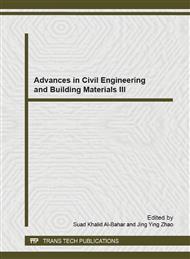p.380
p.387
p.393
p.401
p.407
p.413
p.418
p.423
p.430
Joint Displacement Evaluation of a Modular Road System
Abstract:
Transportation agencies have recently been struggling to carry out rapid roadway construction and repair work with minimal disruption to the motoring public, and they are pursuing sustainable and perpetual roadway systems with minimal maintenance over their service life. This study sought to develop a roadway joint system as a part of research on a sustainable-perpetual-modular (SPM) roadway system. In this study, two boundary conditions were considered with varying support offsets. Dead load, live load, and temperature load were considered and the corresponding displacements were computed. Roller supports at both ends produced larger displacements compared to hinge supports at both ends. Analysis results exhibited that a support offset equal to 0.0 m produced the smallest displacement. The results of this study will provide valuable information for the design of modular roadway joint systems.
Info:
Periodical:
Pages:
407-410
Citation:
Online since:
December 2013
Authors:
Keywords:
Price:
Сopyright:
© 2014 Trans Tech Publications Ltd. All Rights Reserved
Share:
Citation:


